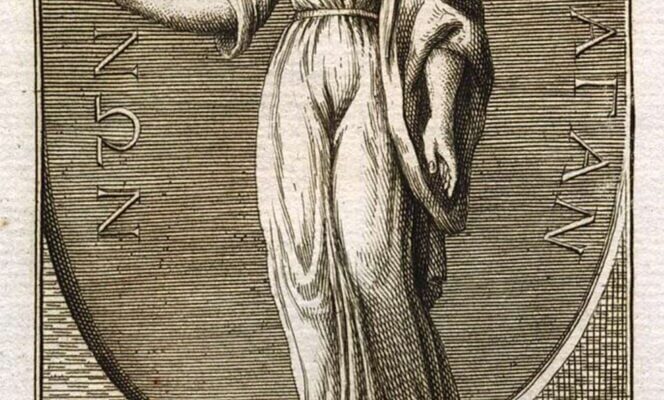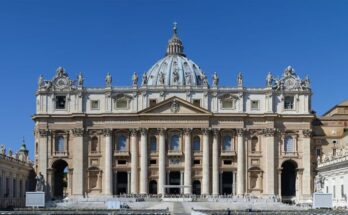
A small, faded papyrus fragment, brown in color and unremarkable at first glance, has been found to contain script from Empedocles. The writing is all in capital letters and in charcoal ink.
The fragment was discovered in 2021 by Belgian papyrologist Nathan Carlig in Cairo while cataloging papyrus at the French Institute of Oriental Archaeology. It has a hole in the middle and features a cut-out below that. Above, there are two Greek columns: the left side displays the ends of 13 lines, while the right side shows the beginnings of 17 lines.
The fragment measures 10.9 cm (about 4.25 inches) wide by 13.2 cm (just over 5 inches) high.

The significance of the papyrus fragment discovery
In the early 20th century, Fouad I, King of Egypt and a patron of letters, assembled Egypt’s first collection of ancient papyri under the Institut de France. The fragment has been named the Fouad Papyrus, number 218. Carlig suspected the fragment’s significance but needed help since he was not a Hellenist.
He turned to Hellenistic papyrologist Alain Marten at the University of Brussels and classical philologist Oliver Primavezi at the University of Munich. Surprisingly, the unassuming fragment turned out to be a significant treasure.
Papyri from the late pre-Christian and early post-Christian periods found in Italy and Egypt rarely contain significant text, often being mere records or receipts. However, there are notable exceptions.
Professors Marten and Primavezi, in the 1990s, discovered 52 papyrus fragments from the 1st century AD at the University Library of Strasbourg. These fragments contained dozens of verses from Empedocles’ cosmological poem “On Nature,” which was published in 1999 as “Empedocles of Strasbourg.”
Now, twenty-five years later, another significant discovery has been made. According to research presented at the University of Frankfurt in June, the Fouad Papyrus is likely an excerpt from the same edition of “On Nature” as the Empedocles of Strasbourg. We expect the critical and interpretive edition by the end of the year.
Unveiling Empedocles’ philosophy on cosmogony
Empedocles lived in the 5th century BC and was the eccentric heir of a wealthy family from Akragas. Politically, he sided with the democrats against the oligarchy and embodied the mystic, healer, poet, and philosopher.
Empedocles traveled between city-states with a long mane, a crimson cloak, a crown, his signature copper slippers, and a retinue of devoted followers. He was a prolific poet, writing thousands of verses, with his most important works being “On Nature,” which was about the genesis and evolution of the world, and “Purifications,” which was about the fate of the soul.
In “On Nature,” Empedocles dialectically reconciles the absolute immobility theory of Parmenides, a pre-Socratic Greek philosopher who believed that all of nature is one and constant or unchanging, with the unrestrained movement idea of Heraclitus, who believed that the basis of the universe is change.
Empedocles describes how the four foundational elements—earth, water, fire, and air—combine and separate under the alternating forces of Love and Strife within the cosmic sphere.
The Strasbourg fragments illuminate the details of Empedocles’ cosmogony and reveal key aspects of his philosophy. For Empedocles, the sphere was never the absolute beginning, as in each phase, every sphere results from a new process.
Even during the dominance of Strife (Neikos in ancient Greek), which is responsible for chaos and separation, the four elements remain separate but never stagnant. They exist in a state of effervescence, while, in the sphere’s heart, Love (Philotes in ancient Greek), the cause of creation, prepares to push Strife back to the sphere’s edge so that the cycle may once again be repeated.
This is a process that takes thousands of years. Empedocles’ philosophy captivates with its depiction of permanent constants in perpetual motion.
Deciphering ancient texts and the legend of Empedocles
Until recently, all known passages of Empedocles’ works were quotes from later authors. The first direct passage was “Empedocles of Strasbourg.” The Fouad Papyrus now supplements this text.
Primavezi explained that the “flows” in the left column describe the sphere’s disintegration under Strife’s attack. Meanwhile, the right column’s dactylic hexameters allude to Empedocles’ theory of sensory function. Empedocles believed particles of fire cause the visual perception of brightness.
The philosopher stands out as a brilliant figure of his time, and, according to legend, he even believed himself to be a god. To prove his invulnerability, as per legend, he entered Mount Etna’s crater as his followers watched, and no one saw him again—save for his bronze slippers, the only things that emerged unscathed from the volcano’s depths.



